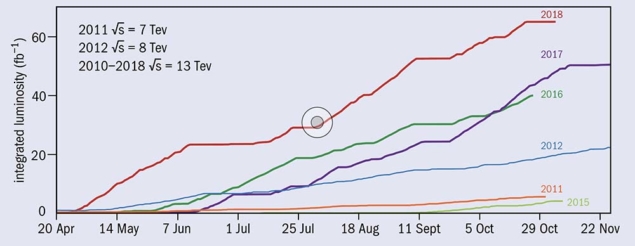
The Large Hadron Collider’s 2018 proton physics run came to an end on 24 October, having accumulated an impressive dataset. The integrated luminosity delivered to both the ATLAS and CMS experiments reached an average of around 66 fb–1 for the year, 10% higher than the target. This corresponds to around 5 × 1015 inelastic collisions per experiment. LHCb accumulated just under 2.5 fb–1, while ALICE notched up 27 pb–1. The high figures are due to excellent machine availability and an instantaneous luminosity that regularly touched 2 × 1034 cm–2 s–1 in ATLAS and CMS – twice the nominal value.
The end of the proton run was followed by three and a half weeks of lead–lead collisions at a centre-of-mass energy of 5.02 TeV per colliding nucleon pair. Beginning on 5 November, this is the fourth lead–lead run since the collider began operation. During the last run of this type in 2015, the luminosity achieved was more than three and a half times higher than the LHC’s design luminosity, and the goals for 2018 are even more ambitious. Lead ions were also collided with protons in the LHC back in 2016.

This year’s shut-down marks the end of LHC Run 2, which began in 2015 and saw proton collisions take place at a centre-of-mass energy of 13 TeV. The total data accumulated since the start of Run 2 corresponds to an integrated luminosity of 160 fb–1 to both ATLAS and CMS. From 10 December, CERN’s accelerator complex will enter “long shutdown 2” and undergo an extensive programme of renovation and upgrades, in particular for the High-Luminosity LHC. A week of LHC magnet training tests for operation at a future proton collision energy of 14 TeV is one of the first activities.
High performance
In terms of performance, LHC Run 2 has been a major success for both the machine and its detectors. In terms of physics output, highlights from ATLAS and CMS include several key measurements of the Higgs boson’s properties, in particular its couplings to top and bottom quarks and to tau leptons, and numerous searches for physics beyond the Standard Model. LHCb has found a clutch of new hadrons, deepening our understanding of strong interactions, and has accumulated interesting results concerning the universality of lepton couplings. In the sphere of nuclear collisions, ALICE has dug even deeper into the extreme dynamics of the quark–gluon plasma – also finding strong evidence that this state is produced in proton–proton collisions.
This is just a flavour of the numerous results produced. So far, no firm signs of physics beyond the Standard Model have been seen at the LHC, but the majority of data collected during Run 2 are still to be analysed. Between now and the return of protons for Run 3 in 2021, the LHC experiment collaborations will throw everything they have at the data to see if anything new is lurking in the Run 2 data.





